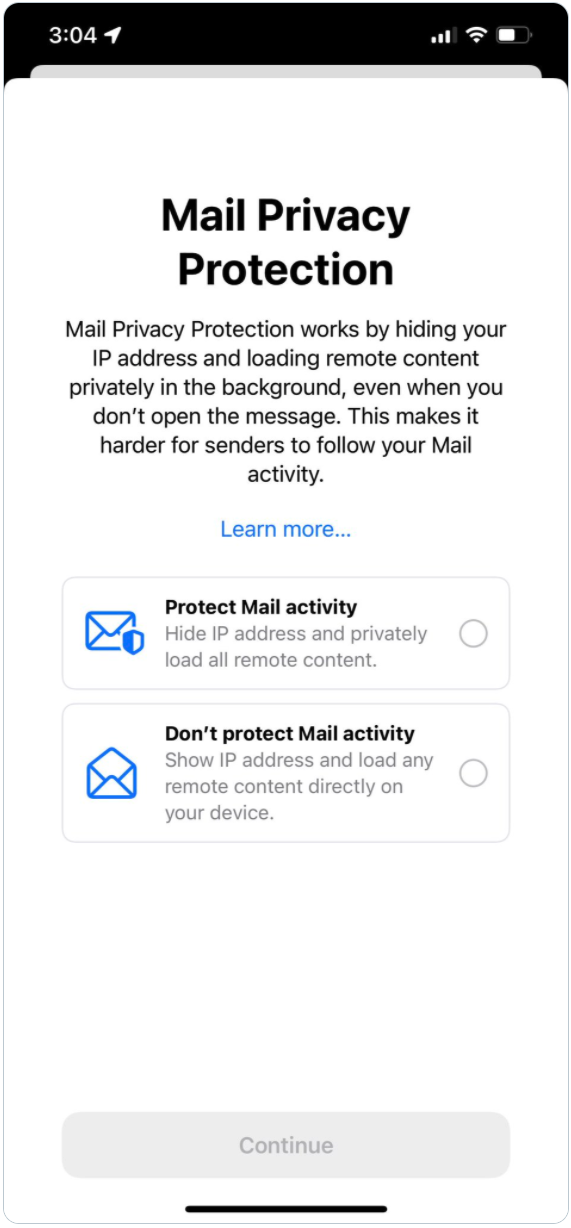Email best practices
Apple Mail Privacy Protection: Is email marketing dying again?

Email best practices

The world of email marketing imploded this week – yet again – when Apple announced its new Mail Privacy Protection for the Apple Mail app during the 2021 edition of the Worldwide Developers Conference (WWDC 2021).
During the event, Apple announced the release of new features to help users control and monitor apps’ use of their data, including options to limit email tracking on the Mail app. In other words, Apple Mail will prevent senders from knowing who opens their emails. Cue panic attack.
Well, the news has certainly gotten email senders talking about the implications these new features could have on the way we measure and track emails. The Mail Privacy Protection will launch later this year – sometime between September and November – and will affect iOS 15, iPadOS 15, and macOS Monterey devices.
In its official announcement, Apple says: “In the Mail app, Mail Privacy Protection stops senders from using invisible pixels to collect information about the user. The new feature helps users prevent senders from knowing when they open an email, and masks their IP address so it can’t be linked to other online activity or used to determine their location.”
This new feature will impact any emails users read using the Mail app on Apple devices, regardless of the email client. But what about emails read on an iPhone using the Gmail app? You don’t need to worry about those – the new Mail Privacy Protection features apply only to the Mail app.
All around the world, users are demanding more control over their personal data, and it certainly looks like (some) technology providers and countries are starting to listen. Over the last few years, governing bodies in the EU and the US have passed laws to protect consumer data privacy, like GDPR, ePrivacy, CCPA, or the Virginia Consumer Protection Act.
With the new Mail Privacy Protection, users will be able to select whether they want to protect their activity from third parties or not. If they choose the “Protect Mail activity” option, Apple Mail will hide their IP and load remote content privately.

Source: Ryan Jones on Twitter
Most users will likely choose to hide their activity from third parties. And while more privacy is always good news, the Mail Privacy Protection might also come with some inconveniences. Open rates are used as a way to analyze engagement and clean email lists, so these users could also end up seeing more unwanted email in their inboxes.
In short, it means senders won’t be able to track email open rates, and content dependent on location won’t be accurately displayed when an email is opened on Apple Mail. All emails sent to Apple Mail users that have enabled Mail Privacy Protection will be displayed as opened, even if the recipient ignores it. Imagine that – 100% open rates… Cool, right? Well, not so much. Automatic opens will affect the way we track and measure email performance, but it might also impact campaigns that use opens as a filter or a trigger.
Open rates have been the standard go-to metric for many email marketers over the years, although some senders have started to look beyond opens to measure the performance of their email campaigns in recent times. While open rates are not the perfect indicator to determine whether a user has read your email – who hasn’t opened and ignored a message before? – it has a huge impact on many aspects of the email strategy.
We still don’t know much about Apple’s Mail Privacy Protection, but here are a few things that might be affected by the inability to track open rates and location:
This all sounds pretty scary, we know. But remember, these changes will only affect people using Apple Mail. In our 2021 email engagement report, only 13.3% of respondents said they used the Mail app to open and read their personal emails. Those using other apps, like Gmail (52.3% of respondents), won’t be impacted by Mail Privacy Protection.
With email marketers everywhere trembling, we asked our team of deliverability and data protection experts what they thought about the news. Here’s what they think… and why you shouldn’t worry too much about email marketing dying anytime soon.
If the ability to mark email as spam didn’t kill email marketing when it was introduced 20 years ago, then we don’t have to worry about Apple’s Mail Privacy Protection ending email marketing now. Senders will adapt and learn to look at other indicators.
Apple is one of the major players in today's ever-changing technology landscape. That is why it is so important that it does take a societal responsibility in putting privacy at the forefront of its products and features. The Internet of things, email included, is such an adaptable field. The new privacy changes will not affect marketers too much, as they will adapt and find more creative, but privacy-centric solutions.

The direct consequences of the AppleMail change are still unclear. People in the industry have very varied opinions – some say Apple just killed email marketing, and others say it won’t change anything. To me, this means email marketers will need to find other metrics to determine how well their email program is performing, instead of only looking at the open rates. And they will adapt to the new normal, and endure, as they always have.

There has been a lot of chatter in the past couple of years about this sort of thing happening, so Apple’s decision doesn’t come as a big shock to me. It will make things more challenging, but everyone will be on the same playing field so I don’t think this should be a big concern. Email is already dead, anyways – at least that is what I’ve been hearing since I started working in email eight years ago!

OK. So no need to panic. But how can you prepare for this new feature?
First of all, breathe in slowly, and then breathe out again. Remember when we thought we were not going to survive GDPR? And yet, here we are.
Next, it is time to start looking beyond open rates as a way to measure the performance of your email strategy. Pay attention to other metrics, including delivery rates and click-through rates, and benchmark your campaigns based on them. You should also start testing to understand what works and doesn’t work with your email list. What content is your audience looking for? What drives your contacts to click through?
And finally, be even more vigilant with your email list health. Monitor your reputation, leverage tools like email verifications to ensure list quality, and look for help when needed. At Pathwire, our team of deliverability experts uses a range of different metrics to monitor email deliverability. We might be biased, but we think they’re the best email partners any company could wish for.
Get unmatched deliverability with PathwireKeep your email deliverability under control. Our team of experts is ready to help you solve the hard problems, so you can go back to growing your business.
Want to make sure you never miss another email-marketing-is-doomed moment? Sign up for our newsletter and get the latest email news in your inbox!